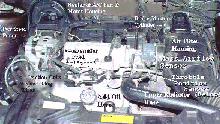
AutoTips Under
the Hood page
A Few Common Under the hood repair & maintenance
items:
Click on image for larger view of this 6 cylinder engine with some common parts identified.
Click here for image of a 4 cylinder engine with some common parts identified.
Click on the links below for a picture of the item. Press your back button on your browser to return here.
Air Idle Control Motor , ICM or Air Bypass Valve regulates the air at idle through the throttle body. The car's computer controls the amount of air going into the engine by controlling the AICM, or other similar valve. These replace the function of the idle speed screw used on the older carburetors which held the air plates (or butterfly valve) open a small amount. Common problems for the air valves are deposits that cause the valve to stick or become plugged. An aftermarket repair or factory shop manual may list the test and maintenance procedures. Symptoms of a defective or plugged unit can include rough idle, or a car that wants to die at idle, but runs well above at normal driving speeds. The Idle Speed Motor (right) works similar to the Air Idle Control motor.

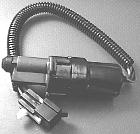
Alternator (AutoTips
Alternator Page)- Charges and works in conjunction with the
battery to provide electrical power for the car.
Alternators are a common failure item on cars. To properly test an alternator,
you need to measure the voltage and current out. Many auto parts stores
have testers to do this if you take the alternator in, or may have equipment
to test the alternator on the car.
Quick Test: With a d. c. voltmeter, you can do a quick test to give you a clue. When idling, with accessories off, most cars will charge the battery from 13.2 to 15 volts. You can turn on some accessories, (or headlights) and the battery voltage should stay in this range. If the car has many accessories, you may need to rev up the engine a bit for the alternator to keep up with the load. If the output is low, it could be a bad alternator, bad regulator (often part of the alternator), bad connections (see batterm.htm ) , or a loose fan belt around the alternator. If the output is high, it is probably the result of a bad regulator, or connection.
Battery - A fully charged battery should measure about 12.3 to 13.2 volts with your engine off. The capacity of a battery drops as the temperature drops. The two main ratings on a battery are cold cranking amps and reserve capacity. (check the AutoTips battery links for details) There are still some battery types that require adding water. It is important to keep the terminals clean (see Battery Tips ) not only for starting, but so the charging system can work properly.
Brake Master Cylinder - Check the brake fluid on the tank on top of the master cylinder. Many auto makers recommend changing the brake fluid at regular periods. Brake fluid is rated for DOT (Department of Transportation) 3 or 4. Type 4 is a higher performance and should substitute for type 3. There are other types, in any case, check with your owners manual for the proper type. Through the brake cylinders, pressure is applied to the disk brake pads (below left), common on front wheels, and brake shoes (below right), common on the back wheels.
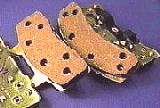
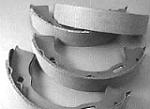
Coolant in the radiator should be checked when the engine is cool. Normally coolant is checked at the coolant recovery tank. Shown is the radiator cap, which should be checked to be clean and free of deposits.
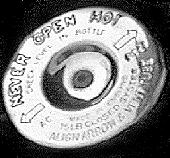
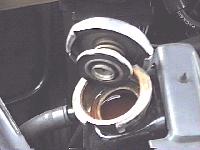
EGR Valve - The Exhaust Gas Recirculation valve mixes
exhaust air with intake air, to re-burn some of the exhaust. This
lowers peak burning temperature and helps emissions. Shown is a "digital"
egr valve.
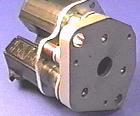
Ignition Parts
Cap, Rotor and Spark Plug Wires: - The Cap
and Rotor are on cars with a distributor (under the cap and rotor). Many
newer vehicles do not have a distributor, it has been replaced by a ignition
coil pack or an ignition coil for each spark plug.. The distributor, cap & rotor can be inspected for burned
contacts on the inside. You can clean the wires and extend their life,
or replace them. Dust and dirt on the wire and end caps will hold moisture
and form a conductive layer to the high voltage, which can drain away energy
that should be going to your spark plugs. Resistor wires are used on most
vehicles to reduce radio static, and reduce electrical noise from getting
into the car computer. Do not replace resistor wires with non-resistor
wires if your car calls for resistor type. Damage to the car's ignition
system can result.
The Fan Motor for the radiator is a common replacement item. Mostly used on front wheel drive cars with a transverse mount engine. A coolant temperature sensor either controls the fan motor directly, or provides a signal to the computer, which turns on and off the fan as needed. On some cars, the fan motor will run whenever the air conditioning compressor is running as well. Shown are the motor, inside view with the windings on the rotor, and the magnets on the other half.
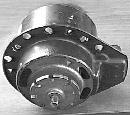
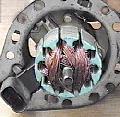
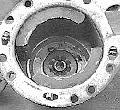
Fuel Injectors The photo shows the connectors which are on top of the fuel injectors. These generally last a long time, a frequent problem is clogging. To keep them clean, check your owners manual for approved injector cleaning fluid to add to the gas tank, and keep the fuel filter replaced. Ethanol, blended with some gasoline in some locations, also tends to keep the fuel system clean. The author has had several autos with 120,000 to over 150,000 miles and no fuel injector problems using ethanol blend fuels. (See Renewable Fuels Association or American Coalition for Ethanol for more information on ethanol. )
A Fuel Pressure Regulator is used in fuel injected vehicles to maintain a constant fuel pressure at the fuel injectors. Shown is one of several styles of pressure regulators.

The Ignition Control Module controls power
to the ignition coil on some cars, this type receives a signal from a
pickup coil located in the distributor. Cars with a multiple coil
pack and no distributor have another pickup sensor, sometimes called a
crank sensor.

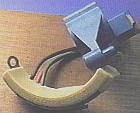
Spark plug wires are designed for the high voltage that fires the spark plug. The long end goes over the spark plug, and should be kept clean. Plug wire removal tools are available to remove the long
boot from the plug without damage. Many newer vehicles do not have spark plug wires, instead a high voltage ignition coil is mounted directly above the spark plug. For more information, see the AutoTips
Plug Wire page.
. 
Other Fluids Shown in the photo are the
windshield washer fluid tank, coolant recovery tank, and power steering
fluid tank. On some cars, the power steering fluid reservoir is stored
on top of the power steering pump. Not shown is OIL level, to check on
the dipstick.
PCV (Positive Crankcase
Ventilation) valves, part of the emissions systems, usually connect to
a vacuum hose. They can become sticky or the rubber grommets can harden
and leak. A vacuum leak can cause rough idle and acceleration. A
problem in the PCV valve can cause oil consumption. If you have had a sudden
increase in oil consumption, and no signs of other oil leakage, or other
problems, check the pcv valve.

Power Steering Pump: - The fluid level should be checked occasionally, some auto makers use Transmission Fluid, and some use Power Steering Fluid. The author has found changing old fluid in a car fixed a stiff steering problem that occurred for the first few blocks after a cold start (when temp was around 15 degrees F & below)
Relays are used to switch large currents with a small current. The photo shows an open relay outside the can.
 Inside
view of relay.
Inside
view of relay.
Sensors (see AutoTips Sensor Page) are used by the vehicle computer to read temperature, air pressure, oxygen content in the exhaust, vehicle speed and other factors used to calculate the fuel delivered to the engine and timing of the ignition, among other things.
Spark Plugs  deliver
the spark that ignite the fuel-air mixture in the cylinders. The
ignitions systems typically produce sparks in the range of 20,000 to 30,000
volts that will arc across the small gap between the center and outer electrodes.
Plugs come in Resistor and non-resistor types. One of the
reasons for resistor type spark plugs is to reduce electrical noise in
the system that would cause static on car radios.
deliver
the spark that ignite the fuel-air mixture in the cylinders. The
ignitions systems typically produce sparks in the range of 20,000 to 30,000
volts that will arc across the small gap between the center and outer electrodes.
Plugs come in Resistor and non-resistor types. One of the
reasons for resistor type spark plugs is to reduce electrical noise in
the system that would cause static on car radios.
Return to Tips page Return to AutoTips home page.
Some images and tips courtesy of:

Discount GM & Ford factory auto parts. Classic car parts.
Shipping available.
If you order from New Whiteland Auto Parts, please let them know
you saw their name on the AutoTips page.
Copyright AutoTips